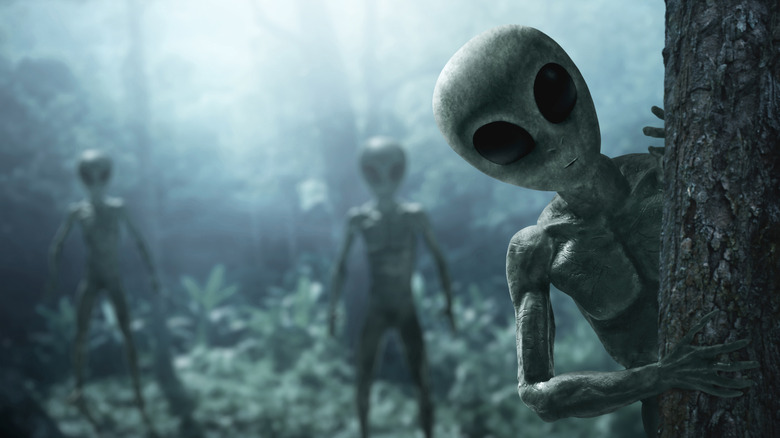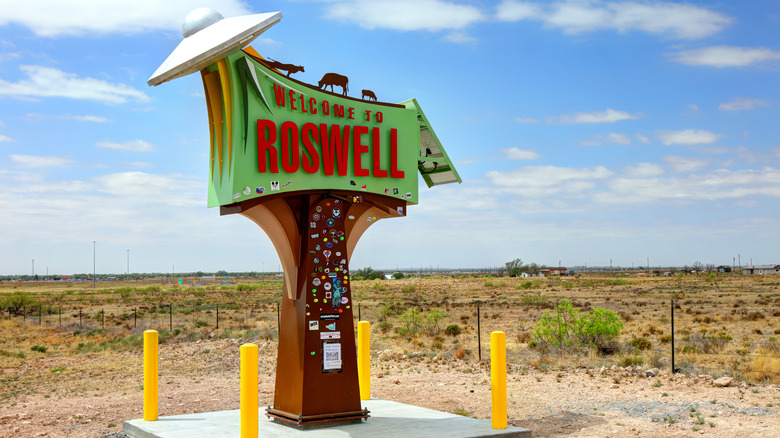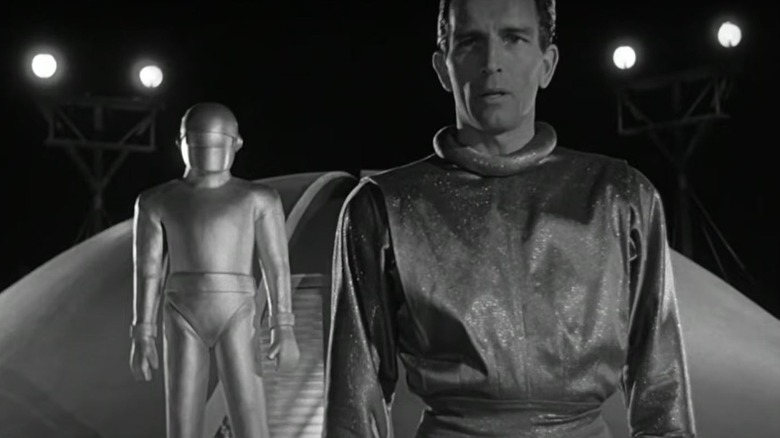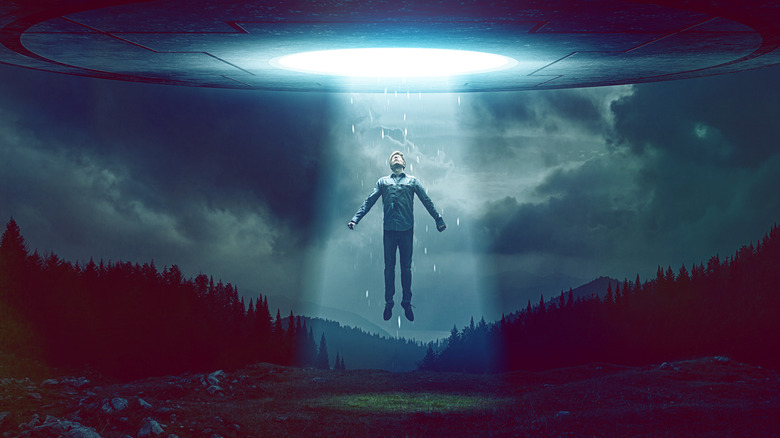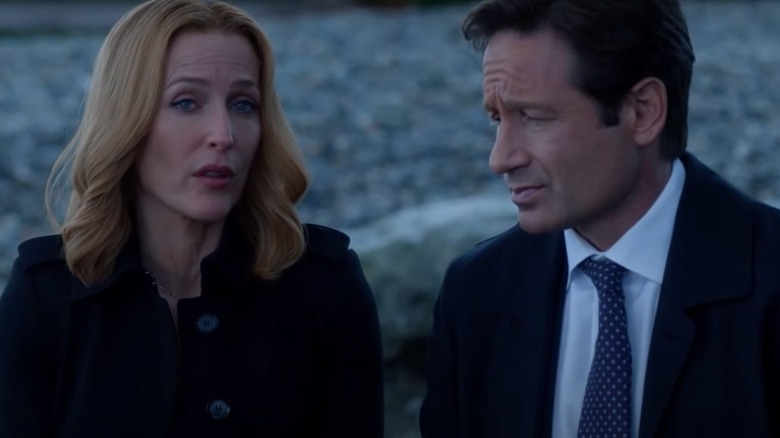Where Did The Grey Alien Imagery Come From?
Okay, quiz time. If we say "alien," what picture comes to mind? Naturally, some folks might imagine gigantic Cthulhu-esque intergalactic tentacle monsters pouring out of space portals or something. But more than likely, folks are going to envision not little green men from Mars, but little grey guys with big heads. We all know the image by now: short, maybe 4 feet tall, extremely thin and with long fingers, giant heads, negligible mouths, and those big, completely black eyes. They don't speak, are telepathic, abduct people from their bedrooms in the wee hours of the night, conduct tests on them, and really dislike being captured by HD video footage. But where did this typical "grey alien" vision come from?
Believers in the crowd may be quick to say, "Duh, we know what aliens look like because abductees told us." As that tale goes, abductees got returned to Earth, spread the word of small creepy dudes from outer space who like to watch you while you sleep, and voila: now we know what the critters look like. Barring the truths of any such claims, reality gets more complicated. The visual portrait of grey aliens — aka Greys, Roswell Greys, Zeta Reticulans, etc. — snowballed over time following the alleged 1947 UFO crash at Roswell, New Mexico. As Today I Found Out says, the little grey alien image got integrated into the stories of supposed abductees in the 1960s and later popularized through media like 1977's "Close Encounters of the Third Kind," and yes, "The X-Files."
Roswell's historic 'weather balloon' crash
While the Roswell, New Mexico incident might not have delivered to the world undeniable proof of the existence of alien life, it did form the bedrock of our entire modern UFO mythos, and led directly to our shared vision of Greys.
The story, recounted countless of times and told again by Sky at Night Magazine, starts on June 24 with pilot Kenneth Arnold, who saw nine unidentified "crescent-shaped objects" flying at about Mach 1.5 (about 1,200 mph). For the record, Charles "Chuck" Yeager didn't officially break the sound barrier until several months later that year on October 14, as the National Air and Space Museum recounts. And if you're thinking that the craft that Arnold saw were experimental jets, you're not alone.
Per Sky at Night Magazine, Arnold said that the craft were wiggling around in a bizarre way, "like a saucer would if you skipped it over water." Newspapers picked up on this description and deployed a term oh so familiar to us: "flying saucers." Mere weeks later, on July 7, 1947, New Mexican rancher W.W. "Mac" Brazel came forward claiming to have found metallic debris scattered around his property. Per Smithsonian Magazine, the Roswell Daily Record — a local paper — ran a story saying that Brazel found a downed flying saucer. Official FBI records state that the object was a hexagonal disc suspended by cords from a weather balloon. But no matter — UFO fever was in full swing.
We come in peace
The timing of the Roswell incident couldn't have been more perfect or more telling. The alleged alien spacecraft crash in Roswell, New Mexico happened in 1947, a couple short years after the end of World War II and at the onset of the United States' decades-long Cold War with Russia. As The Guardian discusses, Roswell embodied and defined the fears and preoccupations of the time: existential threats posed by foreign powers, the contest for technological superiority, and paranoia about hidden identities and agendas.
Within no time Hollywood churned out film after film that framed alien contact as a military battle akin to a terrestrial war between nation states: "The Thing from Another World" (1951), "The War of the Worlds" (1953), "Earth vs. The Flying Saucers (1955)", and many more. Out of all these films, "The Day the Earth Stood Still" — shot in black and white — stands out for its grey-clad alien humanoid Klaatu, grey robot Gort, and grey flying saucer. In other words, lots and lots of grey.
Long before then, H.G. Wells' 1893 short story "Man of the Year Million" provided a model for modern aliens that seeped into popular consciousness over time and got intermingled with films like "The Day the Earth Stood Still." In his story — readable in part on JSTOR — Wells describes a physically frail, future humanity with tiny, thin bodies, no ears, miniature mouths, big heads and faces "like the harvest moon," and "large, lustrous" eyes.
Lost hours on country roads
In 1961, couple Betty and Barney Hill rode the wave of UFO fervor and drafted the template for a tale that's become achingly cliché: alien abduction stories. A lone couple driving in the night along a far-flung country road? Check. Strange lights in the distance? Check. Sucked aboard an alien spacecraft for a bit of unwanted bodily probing? Check. Lost time and repressed memories? Check. Telepathic, hairless alien abductors with grey skin? Check. This is exactly what Betty and Barney Hill claim happened to them in New Hampshire, per Today I Found Out. Although originally, Barney — a World War II veteran — claimed the aliens dressed like Nazis, and Betty claimed they had giant noses.
Betty also said that the aliens showed her a star map of their binary-star home system, Zeta Reticuli, 39.2 light years from Earth. Zeta Reticuli — possibly the greatest sci-fi name ever — is a real system, but Betty's descriptions didn't add up. The couple got their 10 minutes of fame, as Sky at Night Magazine shows, but more importantly they set in motion a rash of abduction stories that repeated the same story beats. Professor of Sociology at Chapman University Christoper Bader writes that physical descriptions of aliens still varied at that point, from "tall, blonde, Aryan[s]" to headless black figures with webbed feet. A UFO community had emerged, however, and needed a central alien image. They'd get their wish come 1977's "Close Encounters of the Third Kind."
The truth is out there
Steven Spielberg's 1977 "Close Encounters of the Third Kind" all but permanently cemented the image of grey aliens in the minds of the public, particularly the ending sequence where protagonist Roy Neary leaves Earth. This was followed up by 1982's "E.T. the Extraterrestrial," also a Spielberg film but featuring a child-friendly grey alien, 1989's Christopher Walken-led "Communion," 1993's ultra-disturbing "Fire in the Sky," and the coup de grâce on alternative alien imagery: "The X-Files," which originally aired from 1993 to 2002.
Nowadays, as Today I Found Out reports, 43% of alleged alien abductees in the U.S. describe their captors as "little grey humanoids." In Australia the number is 50%, and in Canada it's a whopping 90%. And of course, any random person who's never heard a single abduction report, doesn't believe in extraterrestrial life whatsoever, and isn't a classic sci-fi film buff will doubtlessly default to the same small, grey alien image.
At present, belief in aliens is stronger than ever. According to YouGov, 34% of those who've seen a UFO believe it was an alien spacecraft, and only 39% of Americans are doubtful that alien contact will happen within the next 50 years. Meanwhile, the U.S. government released 1,500 pages of UFO-related documents in 2022 and has taken to rebranding UFOs as UAPs: unidentified aerial phenomena. The truth of alien life and appearance remains unknown, but as "The X-Files" says: the truth is out there.
